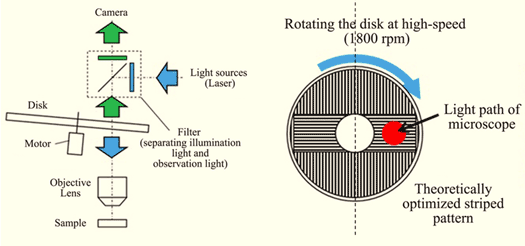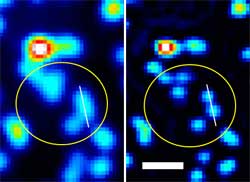News
Uma tecnologia de microscopia de fluorescência de superresolução inovadora — A formação de imagem ultrarrápida da ultraestrutura de células vivas está oferecendo novas abordagens aos fenômenos biológicos.
In a collaborative project with RIKEN (Quantitative Biology Center, Japan), Olympus Corporation (President: Hiroyuki Sasa), through its Scientific Solutions Business, has developed a new super-resolution fluorescence microscopy technology that allows observation of the ultrastructure of living cells with a significant reduction in image acquisition time.
When making microscopic observations, there are certain limits to spatial resolution,*1 i.e., the ability to observe an object in fine detail and the spatial resolution of a general optical microscope is typically about 200 nm maximum.*2 Super-resolution microscopy has broken through these limits, allowing observation of finer structures. The 2014 Nobel Prize in Chemistry was awarded to researchers of super-resolution fluorescence microscopy techniques for their ground-breaking invention that has enabled significant research progress to be made in the life sciences.
Our new technology has made it possible to attain a spatial resolution of about 100 nm, equivalent to that achieved by structured illumination microscopy (SIM),*3 one of several super-resolution fluorescence microscopy techniques, with a temporal resolution of 1/100 second.*4 The new technology allows imaging of the rapid dynamics of organelles*5, which actively move around in living cells. This feat had been unattainable using conventional super-resolution fluorescence microscopy techniques because the time required for image acquisition ranges from about 1 second to several minutes. This major leap forward in super-resolution fluorescence microscopy is expected to significantly expand our understanding of biological phenomena.
This technology can be achieved by modifying conventional confocal microscopes*6 and it is expected that the device can be easily installed compared with other preexisting super-resolution fluorescence microscopes.
The online version of the article on the technology was released (February 25) ahead of the print edition that will be published in the May 1 issue of "Molecular Biology of the Cell," the journal of the American Society for Cell Biology.
Notes:
*1: The ability to distinguish two points or two lines. Smaller values indicate higher spatial resolution, which enables the observation of finer structures
*2: One nanometer (nm) equals one-millionth of a millimeter
*3: An approach that can increase spatial resolution by up to a factor of 2 compared to conventional microscopy by analyzing the moiré interference patterns of 9 to25 images, which are formed by projecting striped patterns
*4: The minimum time change that creates a distinguishable change in the image under observation. Smaller values indicate higher temporal resolution, which enables images that are changing at a high speed to be distinguished
*5: Sub-cellular complexes having specific structures and functions, such as endoplasmic reticulum, Golgi bodies and mitochondria
*6: A type of microscope that enables three-dimensional imaging by focusing an excitation beam on a specimen, and blocking any fluorescent light that is not coming from the focal point.
Scientific Solutions Business:
Olympus Scientific Solutions’ main products include optical microscopes, industrial endoscopes, and non-destructive testing devices. Olympus contributes to R&D in the healthcare, life science and industrial fields, improvements in quality control at production sites, and the safety and reliability of social infrastructures through the inspection of aircraft and large industrial plants.
(Reference materials: research outline)
<Background>:
In the 19th century, a German physicist named Ernst Abbe and other scientists showed that the spatial resolution of an optical microscope is limited to about half the wavelength of the light used (diffraction limit), and it was a long-held belief that the smallest object observable using a visible light microscope was 200 nm. From the 2000s, however, various super-resolution fluorescence microscopes have been developed with the aim of attaining a spatial resolution that exceeds the diffraction limit. This has led to a spatial resolution of 100 nm or less being achieved. These super-resolution microscopy techniques, however, require significant time for imaging, making them unsuitable for live cell imaging, a technique that allows the observation of living cells. In this study, therefore, we focused on the development of a microscope with a temporal resolution of 1/100 sec, which makes live cell imaging possible.
<Technology>:
The analysis focused on structured illumination microscopy (SIM), one of the conventional super-resolution fluorescence microscopy techniques. It was found that there are theoretical similarities between SIM imaging and confocal microscopy imaging. We studied this matter using our disk scanning unit (DSU), and found that super-resolution images that are equivalent in quality to those of SIM can be obtained if the striped pattern on a spinning disk is modified. We accordingly named the technique "Spinning Disk Super-Resolution Microscopy (SDSRM)" (Figure 1).
Next, using fluorescent beads, the spatial resolution of the system was tested in an experiment that was designed to verify the principle, and it was found, in accordance with the theoretical calculations, that a spatial resolution of about 100 nm could be achieved (Figure 2). Further, we succeeded in observing the ultrastructure of living cells with a spatial resolution of 100 nm, at a maximum shutter speed of 1/100 sec (temporal resolution) by changing the camera and illumination source to those that are more suitable for high-speed imaging.

Figure 1. Schematic diagrams of spinning disk super-resolution microscope
Left: Schematic diagram of the light pathway. The illumination light (indicated in blue) and light from the specimen (indicated in green) go through the same position on the disk, creating the confocal effect.
Right: Schematic diagram of a striped pattern on a disk. Super-resolution observation was made possible by making a striped pattern that is finer than conventional patterns.

Figure 2. Proof-of-principle experiment using fluorescent beads
Left: Image obtained using a conventional fluorescence microscope
Right: Image obtained using the spinning disk super-resolution microscope
(scale bar, 500 nm)
<Results>
The development of the spinning disk super-resolution microscopy technique has made it possible to observe the dynamics of ultrastructure in living cells. Because this technique can be realized by modifying conventional confocal microscopes, the introduction of the device is easier compared with other preexisting super-resolution fluorescence microscopy techniques. Further development of the principle of the spinning disk super-resolution microscopy technique should allow its application to other confocal microscopy techniques in principle.
Information on the article
Title: Ultrafast superresolution fluorescence imaging with spinning disk confocal microscope optics
Authors: Shinichi Hayashi and Yasushi Okada
Journal: Molecular Biology of the Cell
DOI:10.1091/mbc.E14-08-1287 (published online before print)
Not Available in Your Country
Sorry, this page is not
available in your country.